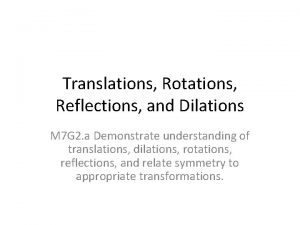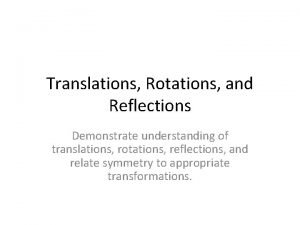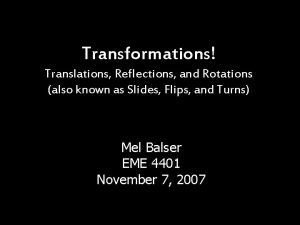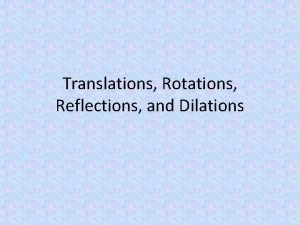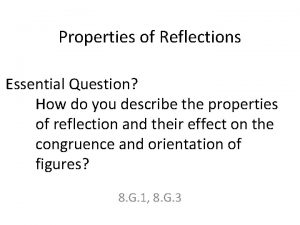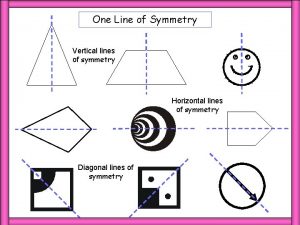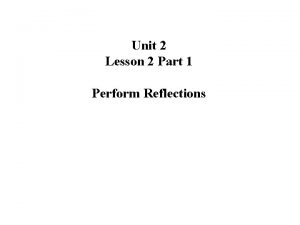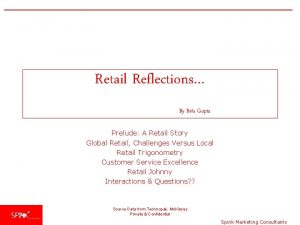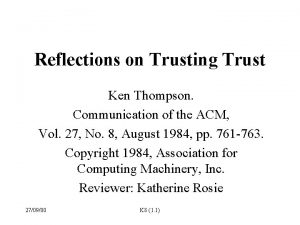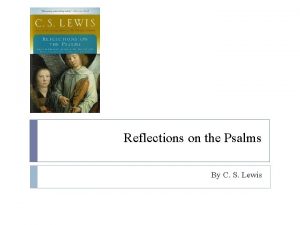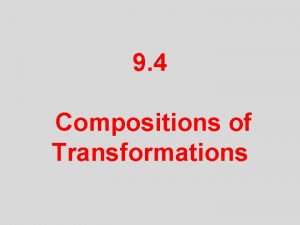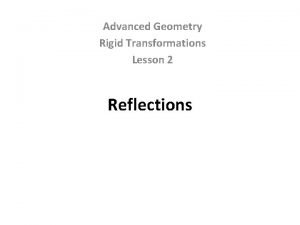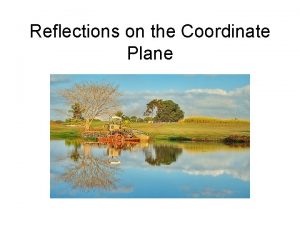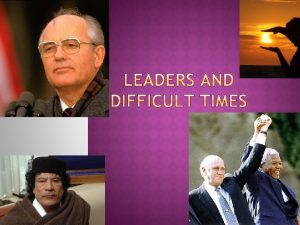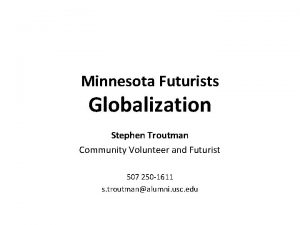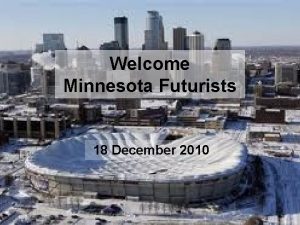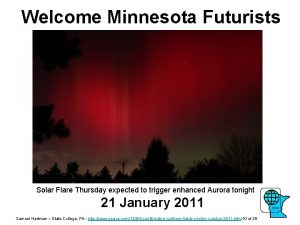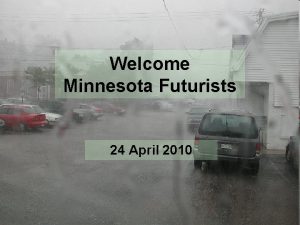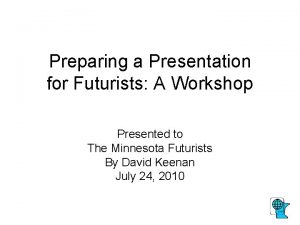Reflections and thoughts from the article Futurists and











![� “The entire end of one room [of a gallery] was given up to � “The entire end of one room [of a gallery] was given up to](https://slidetodoc.com/presentation_image_h/114b414fb53e35da8f81930a37a9f4b4/image-12.jpg)


















- Slides: 30


� Reflections and thoughts from the article: “Futurists and Others in Famished Moscow: Radical Artists Find New Manners of Expression Amid Social Chaos” By Oliver M. Sayler Vanity Fair, September 1919 Online Source: http: //www. oldmagazinearticles. com/pdf/ART%20 russia. pdf

- The following are the author’s words from 1919: � “Russian artists still create in spite of the social chaos that has engulfed all the economic institutions of an elder time and revealed their essential artificiality. ” � “Art alone survives the earthquake shocks of revolution. ” � “And Russian art has been doubly secure because of its deep-rooted imagination and its passionate sincerity. ”

� “It should not be surprising, except to those who have fed blindly on reactionary propaganda to learn that the great public art collections have been guarded carefully and have been of wider civic service under the Bolsheviki than in the days of the autocracy, while the collections in danger from an invading enemy have been stored for safety in the Kremlin vaults in Moscow. ”

� “For all Russians, no matter what class or rank or party, have profound respect and reverence for the products of Russian artistic genius and for the masterpieces of other countries which had become Russian possessions. ”

� “It is not so easy, though, to understand how the artists of today can continue to create while worlds are in a melting pot, and I for one, with all my faith in the virility and vitality of the Russian imagination, was unprepared to find the annual exhibitions crowded with contemporary canvases and marbles during my stay in Moscow and Petrograd through the first six months of the Bolshevik regime. ” � “But crowded they were…”

� “Whatever may be the ultimate value of the work of the revolutionists in oil, their spirit is more in keeping with the times, their understanding of the times is surer, their acceptance of conditions as they find them is readier and their creative vision is more fertile than that of their more conservative brethren. ”

� “Social change, while it disheartens those who worked for the masters of a passing era, gives free rein to bad boy antics as well as to honest experiment. ” � “And time alone can tell us which is which!”

� “Among the honest experimenters, I am sure, in spite of his brusque pugnacity, is David Burliuk, called by his friends the father of Russian futurism. ” � “Burliuk’s impulse, like that of his fellow radicals, preceded the stress of war and the storm of revolution, but that impulse has undoubtedly been intensified by the times. ” � “The father of Russian futurism was born of Cossack blood in the Ukraine in 1882. ” � “[He] was a devotee of impression, later flirting with cubism and finally in 1911 becoming the advocate of futurism which he understands as the psychology of motion, the psychology of the large city. ”

� “To Burliuk, futurism means a protest against refined culture, a defense of the crude but always youthful forms of the archaic. ” � “He believes that our time is a time of synthesis. ” � “His best and most expressive pictures, therefore, are symbolic in execution, although he produces landscapes, portraits, imaginative studies, and decorations in all styles, in addition to writing and publishing his own verse and that of other futurists. ”

� “As he summed it up for me one day, the intellectual basis for his art is this: ‘All styles – all epochs – the good things of the whole world. Not the narrowing but the broadening of the program. Protest against the formula. ‘Art for Art’s sake, ’ for all art is for all – for the mobs, for the streets. Art for the Circus and the Circus for Art!”
![The entire end of one room of a gallery was given up to � “The entire end of one room [of a gallery] was given up to](https://slidetodoc.com/presentation_image_h/114b414fb53e35da8f81930a37a9f4b4/image-12.jpg)
� “The entire end of one room [of a gallery] was given up to his canvases, but he might as well have limited his contribution to one, for a single painting made you forget all the rest. ‘The Angel of Peace Who Came Too Late, ’ Burliuk calls it. With its unspeakably tragic conception, its dull blues and its smoldering reds, and the strange tortuous detail resembling that of Van Gogh, the picture is a relentless and heartbreaking epitome of Russia today. ”

� “Burliuk’s pugnacity, which seems to irritate the staid more than his unconventional paintings, take weird forms at times. ” � “In his symbolic futurist composition, “The Execution of Marie Antoinette in Moscow, 1917, ” by which he contrasts the spirit of the French and the Russian Revolutions, he has painted his own distorted features as a kind of mask over the face of the executioner. ”

� “Another of his paintings, born of the Russian hatred for war and its sacrifices, ‘The War Barrel of the Danaids, ’ in which a solemn procession of mothers comes winding across the mountain to deposit their babes in the capacious maw of destruction, found its way after the close of the exhibition to a commanding position out of doors at the corner of Kuznetsky Most and the Neglinny Proyezd, one of the busiest spots in downtown Moscow, where it stared at the passing populace. ”

� “The closest friend of Burliuk in futurist by-ways is Vassily Kamyensky…” � “If Burliuk is the father of Russian futurism then Kamyensky is its mother…” � “Kamyensky is a native of the Urals, and although he has done some painting, he has spent most of his time in writing. ”

� “Most prolific and successful of the cubist group among the radicals is probably Alexandra Exter …who began like Burliuk in Paris student days as an impressionist and who has travelled through succeeding stages to her present use of cubism to express intensely dramatic characters and scenes. ”

� “Pavel Kuznetsoff … is another radical who has not gone quite far afield in his method. His temper is that of the mystic and symbolist, and ‘The Birth of the Devil’ is his most famous painting. ”

� “Of the whole radical colony, though, the most revolutionary and the most intriguing is Casimir Malyevitch, founder of the school of Suprematism. ” � “Malyevitch began as a cubist about 1910, and he traces the development of his ideas of art and of painting in particular in a pamphlet which he calls, ‘On the Way from Cubism and Futurism to Suprematism. ’”

� “Today, he has renounced all effort to ‘represent’ any scene, object or idea in colors. He uses colors and masses for their own sake and finds that occupation and explanation of his work in the galleries sufficient to take up all the time he is not serving in the ranks of the Red Guard as an ardent Bolsheviki. ”

� Quotes - - from Malyevitch’s pamphlet: “Futurism discovered the rapidity in modern life. ” “The realists, having put live things on canvas, deprive them of the life of motion, and our academies are filled not with ‘studies of life’ but with ‘studies of death’. ” “Suprematism is the pictorial art of colors, the independence of which cannot be reduced to one. The running of the horse can be represented in one tone pencils. But to paint the motion of red, yellow, and blue masses is impossible with the pencil. Painters ought to drop their subjects and ideas if they wish to be pure painters. ”

� “Just what is the sub-conscious intent behind the works of Malyevitch and his followers, I do not know. He is the target of ridicule in Russia, just as he would be in any country. But I found his strange compositions unusually jolly to look at it. In our grey world that is something!” � “I had to go back to Burliuk, though, for a summary of the origins of radical art in Russia today. ”

� “Well, ” he said, “I think the style of modern Russian paintings developed from a study of French painting – western ideas from the year 900 onward carried over to Russian soil. Then, too, it has come from a close study of the art of China and Japan, and from our love for the Russian people and its own olden art – the ikon, the cheap engravings, and the decorations on our wooden utensils. The study of street signs has contributed, also. The new painting still shocks the artistic bourgeoisie, but its influence on life is already immense. ”

� The culture of the late nineteenth and early twentieth centuries was characterized by diversity and innovation � Turning away from Realism in the 1870 s and beyond, artists and writers began to break the rules of traditional culture and experiment with a dazzling array of styles

� Symbolism, Impressionism, Post-Impressionism, and, on the even of World War I, Expressionism, Cubism, and even abstraction

� Most of the nineteenth century had been a time when Western culture was characterized by faith in progress, as well as excitement about new technological and scientific developments � For the most part, especially among the general public, this sense of optimism continued until the eve of World War I

� However, in some ways, the late 1800 s and early 1900 s were becoming a time of crisis and uncertainty in intellectual life � The German philosopher Friedrich Nietzsche not only proclaimed famously that “God is dead, ” but argued that all systems of morality were valueless in the materialistic modern age

� The theory of relativity, elaborated shortly before World War I by Albert Einstein, opened up disturbing new questions in the field of physics for the first time since the days of Isaac Newton

� The early theories of the Austrian doctor Sigmund Freud about dreams and the subconscious probed the secrets of the human mind, laying the foundation of the new science of psychology

� Freud’s insights made many people feel uneasy, both before and after World War I

� And of course, the devastation wrought by the First World War gave artists reason to pause and reconsider their understandings of the world in which they lived
 My thoughts are higher than your thoughts
My thoughts are higher than your thoughts Translation reflection rotation
Translation reflection rotation Rotation reflection translation dilation
Rotation reflection translation dilation Identify reflections, rotations, and translations
Identify reflections, rotations, and translations Translations reflections and rotations
Translations reflections and rotations Congruence transformation definition
Congruence transformation definition Horizontal and vertical reflections
Horizontal and vertical reflections Rotation reflection translation dilation
Rotation reflection translation dilation Properties of reflections
Properties of reflections Line of symmetry
Line of symmetry Trig identities from reflections and rotations
Trig identities from reflections and rotations Reflection translation rotation dilation
Reflection translation rotation dilation Voice localization using nearby wall reflections
Voice localization using nearby wall reflections Reflection visual
Reflection visual Graph the reflection of the polygon in the given line
Graph the reflection of the polygon in the given line Kinseyprivate
Kinseyprivate Reflections on trusting trust – ken thompson
Reflections on trusting trust – ken thompson Trusting trust
Trusting trust Reflections on trusting trust
Reflections on trusting trust C s lewis reflections on the psalms
C s lewis reflections on the psalms Reflection artists gcse
Reflection artists gcse Work reflections for meetings
Work reflections for meetings Scene 1 streetcar named desire
Scene 1 streetcar named desire Practice 9-6 compositions of reflections answers
Practice 9-6 compositions of reflections answers Compositions of transformations
Compositions of transformations 9-1 reflections
9-1 reflections Reflecting points on a coordinate plane worksheet
Reflecting points on a coordinate plane worksheet Lesson 2 reflections
Lesson 2 reflections Reflections copenhagen
Reflections copenhagen Reflections in the coordinate plane
Reflections in the coordinate plane Practice 12-1 reflections answer key
Practice 12-1 reflections answer key


